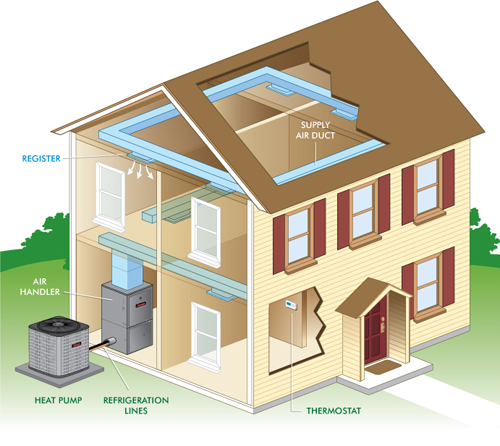 AC Heating 101
AC Heating 101
Furnaces
A Residential Furnace keeps your home warm during the cold months, and can be an integral part of a central air conditioning and/or indoor air quality system.
The basic components of a furnace system are:
A burner, through which gas (natural or propane) or oil is delivered and burned.
A heat exchanger, where the heat produced from the burning gas is transferred to the air distribution system.
Ductwork to transfer the heated air throughout the home.
A flue or vent pipe, to exhaust by-products of combustion (such as water vapor and carbon dioxide) to the outside.
AFUE%
Annual Fuel Utilization Efficiency. A measure of a furnace’s heating efficiency. The higher the AFUE%, the more efficient the product. The government’s established minimum AFUE rating for furnaces is 78%.
Single Packages
A Residential Single Package System is a year ’round comfort system in which all equipment is self-contained in one unit and installed outdoors, typically on a concrete slab or other platform. In the summer, a single package system provides the comfort of central air conditioning.
During the colder months, the unit provides heat. Essentially, it is an air conditioner and heating unit in a single package, hence the name.
Models are available using:
- Electricity for resistance heating and cooling.
- Gas for heating and electricity for cooling.
- Heat pump models using electricity.
The efficiency of single packages are rated using SEER (for cooling efficiency), AFUE% (for gas heating efficiency) and HSPF (for heat pump efficiency). Ductwork is required to transfer the heated or cooled air throughout the home.
Cooling 101
To help you better understand the cooling process, please look over the material below. This is general information that you will find helpful when working with a dealer.
Central Air Conditioning
A Residential Split System Central Air Conditioning system keeps your entire home cool in the warmer months, while it helps lower indoor humidity levels.
System elements include a compressor, a fan, condenser coil, evaporator coil, and a refrigerant. The unit extracts heat from indoor air and transfers it outside, leaving the cooled indoor air to be re-circulated. The efficiency of central air conditioning systems is measured by its SEER.
Three elements make up a central air conditioning system with electricity as its power source. They are:
- An outdoor section (the condensing unit).
- A matching indoor gas or oil furnace with coil, or air handler.
- Ductwork to transfer the cooled air throughout the home.
SEER: Seasonal Energy Efficiency Ratio. A measure of an air conditioner’s cooling efficiency. The higher the SEER, the more efficient the product. The government’s established minimum SEER rating for air conditioners manufactured after January 2006 is 13.
Heat Pumps
A Residential Split System Heat Pump is a year ’round comfort system. In the summer it draws heat out of your home to keep it cool, and in the winter it draws heat from outside air into your home to keep it warm. Many heat pump installations have electrical resistance heater that automatically supplements heat brought in from the outside.
Outside air always has heat in it – even at very low outdoor temperatures.
The efficiency of Heat Pumps is rated using SEER (for cooling efficiency) and HSPF (for heating efficiency).
A Heat Pump uses electricity as its power source, and requires:
- An outdoor Heat Pump section.
- A matching indoor gas (natural or propane) or oil furnace with coil, or air handler.
- Ductwork to transfer the heated or cooled air throughout the home.
HSPF: Heating Seasonal Performance Factor. A measure of a heat pump’s heating efficiency. The higher the HSPF, the more efficient the product.
Air Cleaners and Other Accessories
Home comfort is more than just heating and air conditioning. It also depends on regulating the flow of heat, eliminating drafts, and improving the quality of the air you breathe.
Electronic and Media Air Filters
Electronic air cleaners can remove up to 95% of airborne dust, pollen, odors, tobacco, and cooking particles. Advanced passive media filters are up to five times better at cleaning than typical furnace filters. Both are installed in your home’s ductwork, typically adjacent to a furnace or air handler. Effective filtration systems can help maintain or improve the operating efficiency of heating and cooling equipment. Operating costs savings have been projected as high as 15% over the life of the system.
Seasonal Tips
Maintenance
Follow manufacturer’s routine maintenance directions.
Have entire system checked once a year by a qualified service technician.
What Homeowners Can Do:
Check Filters
Permanent – Clean with mild detergent, per manufacturer’s recommendations, every 30 to 60 days.
Replaceable – Replace every 30 to 60 days.
Windows and Doors
Keep closed when system is running.
Caulk and weather strip to close air gaps.
Close drapes and shades over windows facing sun.
Activities
During cooling season, don’t wash/dry clothes during warmest times of day (late morning and afternoon).
When cooking, use exhaust fan only as needed.
Keep thermostat at desired setting.
What is a Ductless Heat Pump System?
A Ductless Heat Pump System is a highly efficient heating and cooling system. It is installed as a new primary heat source for electrically heated homes. These systems heat and cool homes at a fraction of the cost of baseboards and wall heaters. Ductless Heat Pumps are much safer, quieter and heat rooms evenly (no more hot or cold spots). Ductless Heat Pumps use a inverter driven compressor, are ultra quiet, zone heating & cooling, and can cut your heating costs up to 60% with utility rebates of up to $1500
Ductless systems do not require expensive and invasive ductwork. They require only a three-inch opening in the wall or ceiling. Installation is as simple as mounting the indoor and outdoor units, connecting the refrigerant lines, and making a few electrical connections.
